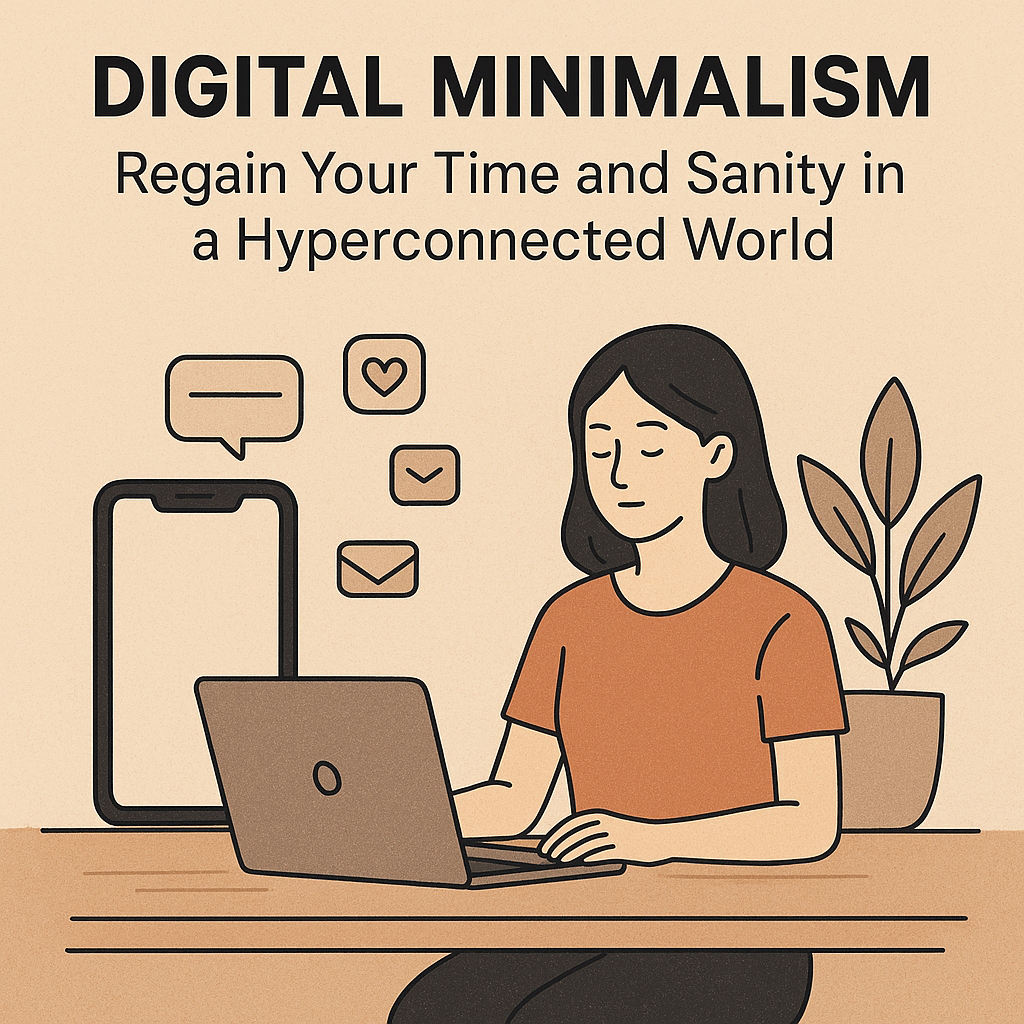In today’s fast-paced era, our lives revolve around screens. From smartphones and laptops to social media and constant notifications, we are hyperconnected 24/7. While technology brings convenience, it also steals our focus, peace of mind, and even our sleep. Many people try a digital detox—a temporary break from screens—but often fall back into old patterns once the detox ends.
That’s where digital minimalism comes in. Unlike a short-term detox, digital minimalism is a lifestyle shift. It’s about intentionally using technology so it serves your values instead of controlling your life. This approach helps you regain your time, attention, and emotional balance in a hyperconnected world.
In this article, we’ll explore the principles of digital minimalism, its benefits, and practical steps to adopt it in daily life.

What is Digital Minimalism?
Digital minimalism is a philosophy popularized by author Cal Newport. It’s the idea of using digital tools mindfully and only in ways that add real value to your life. Instead of cutting off technology completely, you learn to declutter your digital world and focus on what truly matters.
Think of it like cleaning your home. A digital detox is like throwing things in the closet to hide the mess temporarily, while digital minimalism is like decluttering room by room and creating sustainable habits so your space stays organized.
Why Digital Detox Alone Isn’t Enough
Digital detoxes are helpful to reset your brain and reduce screen fatigue, but they’re temporary. Once you re-enter the digital world, endless scrolling, binge-watching, and constant notifications pull you back in.
Without a long-term framework, the cycle continues. Digital minimalism, on the other hand, creates lasting balance between technology and your well-being.
Core Principles of Digital Minimalism
- Intentionality Over Habit
Use technology for a clear purpose instead of mindless habit. Ask yourself: Is this adding value to my life? - Less but Better
Choose a few digital tools that genuinely help you—like a meditation app or an educational podcast—and let go of the rest. - Focus on Real-Life Connections
Prioritize face-to-face conversations and meaningful offline activities over shallow digital interactions. - Create Healthy Boundaries
Limit when and how you use technology. For example, no screens during meals or before bed. - Prioritize Deep Work and Leisure
Use reclaimed time for deep, meaningful work, hobbies, or rest instead of distractions.
Benefits of Digital Minimalism
Adopting digital minimalism can transform both your personal and professional life:
Better Focus & Productivity – Without constant notifications, your brain can concentrate on tasks deeply.
Improved Mental Health – Reducing online comparison and digital overload lowers anxiety and stress.
Stronger Relationships – More quality time with loved ones, without phones interrupting.
Restful Sleep – Cutting late-night screen time improves sleep quality.
More Time for Passions – Reading, hobbies, fitness, or nature walks can replace endless scrolling.
Practical Steps to Embrace Digital Minimalism
Here’s how you can start implementing digital minimalism in daily life:
- Audit Your Digital Life
List down all the apps, platforms, and devices you use. Highlight the ones that truly serve your goals and eliminate the rest.
- Turn Off Non-Essential Notifications
Most notifications aren’t urgent. Disable them and check messages at specific times.
- Declutter Social Media
Unfollow accounts that don’t inspire you, limit platforms to the ones that add real value, or delete apps altogether.
- Set Digital-Free Zones
Create spaces or times in your day where no devices are allowed—like during meals, family time, or the first hour after waking up.
- Use Technology With Intention
Before picking up your phone, ask: What’s my purpose? If you can’t answer, put it down.
- Rediscover Offline Joy
Replace screen time with offline activities—journaling, exercising, cooking, or meeting friends.
- Try “Batching” Online Tasks
Check emails and social media only at scheduled times instead of reacting instantly.
- Invest in Simplicity
Minimalist devices (like e-readers or distraction-free writing tools) can help reduce temptation.
Digital Minimalism vs. Digital Detox: Which is Better?
Digital Detox is short-term and helps reset your brain.
Digital Minimalism is long-term and creates lasting habits.
The best approach is to start with a digital detox (like a weekend without social media) and then transition into digital minimalism to sustain the benefits.
Real-Life Examples of Digital Minimalism
Professionals: Many entrepreneurs use digital minimalism to focus on deep work and avoid constant email interruptions.
Students: Reducing social media use helps students concentrate on studies and reduces exam stress.
Families: Parents who set device-free zones often report stronger bonds and more meaningful family time.
How Digital Minimalism Restores Sanity
We live in an attention economy where apps compete for our focus. Digital minimalism helps you reclaim control. By reducing noise, you create space for clarity, peace, and creativity.
It’s not about rejecting technology but using it wisely—so it becomes a tool rather than a master.
Final Thoughts
Digital minimalism is more than a trend—it’s a way of living with clarity and purpose. In a hyperconnected world, your attention is your most valuable asset. By practicing digital minimalism, you can regain your time, improve mental health, and build a more fulfilling life.
Instead of letting screens dictate your day, let technology serve your goals. Start small—delete an unused app, silence notifications, or set screen-free hours. Over time, you’ll notice more focus, freedom, and peace in your life.
Leave a Reply